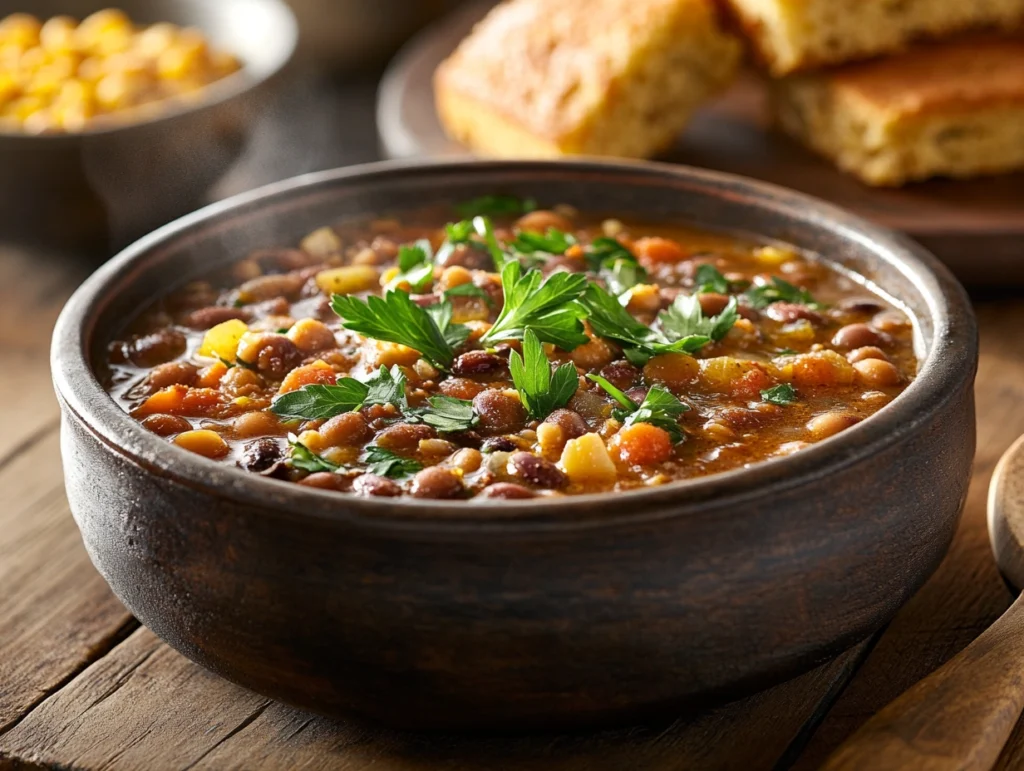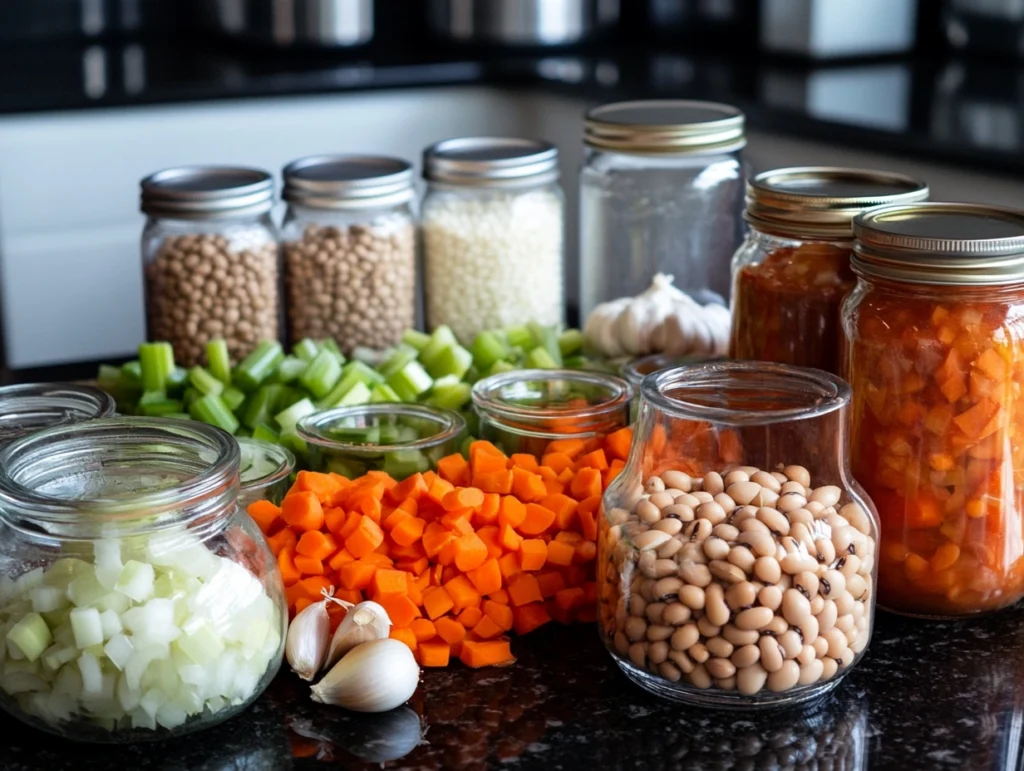1. Introduction
Black-eyed pea soup is more than just a comforting bowl of goodness; it is a dish steeped in history and cultural significance. Known for its hearty texture and rich flavors, this soup is a staple in Southern cooking, particularly during New Year’s celebrations, where it is said to bring good luck and prosperity.

Alt Text: A bowl of black-eyed pea soup with fresh parsley and cornbread on a rustic table.
Beyond its cultural roots, black-eyed pea soup has gained popularity worldwide for its nutritional benefits and versatility. Whether served as a light appetizer or a filling main course, it is a meal that satisfies on every level. This guide will explore everything you need to know about this beloved dish, from its health benefits and cooking methods to common questions and creative variations.
2. Nutritional Profile of Black-Eyed Peas
Black-eyed peas are an exceptional ingredient, celebrated not only for their taste but also for their impressive nutritional profile. Here’s a breakdown of their key nutrients:
Macronutrients
- Protein: Black-eyed peas are a plant-based protein powerhouse, providing about 13 grams of protein per cooked cup. This makes them an excellent choice for vegetarians and those looking to reduce meat consumption.
- Carbohydrates: The complex carbs in black-eyed peas release energy slowly, preventing spikes in blood sugar levels.
- Fats: These peas are naturally low in fat, contributing to their status as a heart-healthy food.
Micronutrients
- Iron: A single cup provides a significant portion of the daily recommended intake, helping prevent anemia and boost energy levels.
- Potassium: Known for its role in regulating blood pressure and supporting heart health.
- Folate: Crucial for cell growth and especially important for pregnant women to support fetal development.
- Vitamin A: Helps maintain healthy skin, vision, and a robust immune system.
Dietary Fiber
Black-eyed peas are rich in soluble and insoluble fiber. This not only supports digestive health but also aids in regulating blood sugar and lowering cholesterol levels.
3. Health Benefits of Black-Eyed Pea Soup
3.1 Supports Digestive Health
The high fiber content in black-eyed pea soup is a game-changer for gut health. Fiber promotes regular bowel movements, prevents constipation, and supports the growth of beneficial gut bacteria. Studies have shown that a diet rich in fiber can reduce the risk of digestive disorders like irritable bowel syndrome (IBS) and diverticulitis.
3.2 Enhances Heart Health
Potassium and fiber work together to improve heart health. Potassium helps maintain healthy blood pressure by balancing sodium levels in the body, while fiber reduces bad cholesterol (LDL). Including black-eyed pea soup in your diet can lower the risk of cardiovascular diseases over time.
3.3 Aids in Weight Management
This soup is both nutrient-dense and filling, making it ideal for those aiming to manage their weight. The combination of protein and fiber promotes satiety, helping you feel full longer and reducing the temptation to snack between meals.
3.4 Provides Essential Nutrients
The folate in black-eyed peas is a standout nutrient, particularly for pregnant women, as it supports the development of the baby’s nervous system. Iron enhances oxygen delivery throughout the body, reducing fatigue and improving energy levels.
4. Culinary Uses and Variations
4.1 Traditional Recipes Across Cultures
In the Southern United States, black-eyed pea soup is often prepared with ham hocks or bacon for a smoky flavor and served with collard greens and cornbread. In West Africa, black-eyed peas are used to create hearty stews spiced with chili and ginger. Caribbean versions may incorporate coconut milk and thyme for a tropical twist.
4.2 Popular Variations
- Vegetarian Black-Eyed Pea Soup: Loaded with vegetables like tomatoes, carrots, and celery, this version is light and healthy.
- Spicy Black-Eyed Pea Soup: Add cayenne pepper, jalapeños, or hot sauce for an extra kick.
- Meat-Lovers Black-Eyed Pea Soup: Incorporate smoked sausage, turkey, or ham for a protein-packed meal.
4.3 Serving Suggestions
Pair this soup with freshly baked cornbread or a crusty baguette. Garnish with fresh herbs like parsley or cilantro, and consider adding a swirl of sour cream or shredded cheese for extra indulgence.
5. How to Prepare Black-Eyed Pea Soup
5.1 Choosing the Right Black-Eyed Peas
Dried Black-Eyed Peas: Offer superior flavor but require soaking and longer cooking times.
Canned Black-Eyed Peas: A quick and convenient alternative, perfect for busy weeknights.
5.2 Preparation Methods
Making black-eyed pea soup can be as simple or as elaborate as you desire. Here’s a step-by-step guide for each preparation method:

Alt Text: Ingredients for black-eyed pea soup neatly arranged on a kitchen counter.
Using Dried Black-Eyed Peas
- Soak Overnight: Place the peas in a large bowl, cover with water, and let them soak overnight. This reduces cooking time and helps remove any potential anti-nutrients.
- Rinse and Drain: After soaking, rinse the peas under cold water and drain thoroughly.
- Cook Until Tender: Boil the peas in salted water for 30–40 minutes until soft but not mushy. Drain and set aside.
Using Canned Black-Eyed Peas
- Drain and Rinse: Empty the canned peas into a colander and rinse well to remove excess sodium.
- Ready to Use: Incorporate them directly into your recipe, as they are pre-cooked and require minimal preparation.
5.3 Cooking Techniques
Stovetop Preparation
- Heat olive oil in a large pot.
- Sauté chopped onions, garlic, carrots, and celery until softened and fragrant.
- Add black-eyed peas, diced tomatoes, broth, and spices like smoked paprika, bay leaves, and thyme.
- Simmer for 30–40 minutes, stirring occasionally. Adjust seasoning to taste.
Slow Cooker Method
- Combine all ingredients in the slow cooker.
- Cook on low for 6–8 hours or high for 3–4 hours. The slow cooking process enhances the flavors, making the soup incredibly rich and satisfying.
Instant Pot Method
- Use the sauté function to soften onions, garlic, and other vegetables directly in the Instant Pot.
- Add black-eyed peas, broth, and seasonings.
- Seal the lid and cook on high pressure for 20 minutes.
- Perform a quick release, stir, and serve hot.
6. Broth Selection for Black-Eyed Pea Soup
6.1 Types of Broth
Choosing the right broth is key to achieving the flavor profile you want. Here’s a breakdown:
- Chicken Broth: Adds a rich, savory base that complements smoky ingredients like bacon or ham.
- Vegetable Broth: A lighter option ideal for vegetarian or vegan versions. Use fresh herbs like rosemary or thyme to enhance its flavor.
- Bone Broth: Offers a deep, hearty flavor along with health benefits like improved joint health and gut support due to its collagen content.
6.2 Tips for Making Homemade Broth
Homemade broth is easier than you might think and allows you to control the flavor and sodium levels.
- Chicken Broth: Simmer chicken bones, onions, carrots, celery, garlic, and herbs in water for 2–3 hours. Strain and store.
- Vegetable Broth: Use scraps of onions, garlic, carrots, and celery, along with herbs, and simmer for about an hour.
6.3 Enhancing Store-Bought Broth
If you’re short on time, you can still make store-bought broth taste homemade:
- Simmer the broth with fresh herbs, a splash of vinegar, or a clove of garlic for added depth.
- Stir in a tablespoon of tomato paste for a richer color and flavor.
7. Role of Baking Soda in Cooking Black-Eyed Peas
7.1 How Baking Soda Works
Baking soda helps soften the outer skin of dried black-eyed peas by increasing the alkalinity of the water. This reduces cooking time significantly and ensures the peas are tender and creamy.
7.2 Guidelines for Using Baking Soda
- Amount to Use: Add 1/4 teaspoon per quart of soaking water.
- When to Add: Use it during the soaking phase or early in the cooking process.
- Caution: Too much baking soda can make the peas overly soft and affect their flavor, so measure carefully.
8. Addressing Common Questions
8.1 What Does Black-Eyed Pea Soup Do for You?
Black-eyed pea soup is a nutritional powerhouse. It offers a wide range of health benefits, including:
- Improved Digestion: The fiber content supports a healthy digestive system and reduces the risk of constipation.
- Energy Boost: Black-eyed peas provide complex carbohydrates, which are digested slowly, ensuring long-lasting energy.
- Immune Support: Nutrients like Vitamin A and iron enhance the immune system, helping the body ward off illnesses.
- Heart Health: Potassium and dietary fiber contribute to a healthier cardiovascular system by reducing blood pressure and cholesterol levels.
Additionally, the dish’s versatility allows you to tailor it to dietary needs, such as low-sodium or high-protein diets, making it accessible to nearly everyone.
8.2 Is Black-Eyed Pea Soup Healthy to Eat?
Yes, it is incredibly healthy. Here’s why:
- Nutrient-Rich: Packed with essential vitamins and minerals, black-eyed pea soup supports overall well-being.
- Low-Calorie and Filling: A typical serving is both low in calories and highly satisfying, making it ideal for weight management.
- Heart-Friendly: Low in saturated fats and high in fiber, the soup is great for heart health.
8.3 What Broth is Best for Black-Eyed Peas?
The best broth depends on your flavor and dietary preferences:
- Chicken Broth: Perfect for a savory and robust flavor.
- Vegetable Broth: Offers a lighter taste and is suitable for vegetarians.
- Bone Broth: Enhances the soup with a deep, rich flavor and adds nutritional benefits like collagen and amino acids.
8.4 What Does Baking Soda Do for Black-Eyed Peas?
Baking soda reduces cooking time by softening the peas’ tough outer shells. This ensures the peas cook evenly and become tender, making them perfect for soup. However, overusing baking soda can result in mushy peas, so use it sparingly and rinse thoroughly.
9. Frequently Asked Questions (FAQs)
What Makes Black-Eyed Peas Unique Compared to Other Beans?
Black-eyed peas stand out for their creamy texture and nutty flavor. Unlike other beans, they have a distinct black “eye,” which is actually a small black mark where the seed was attached to the pod.
Can Black-Eyed Pea Soup Be Made Ahead of Time?
Yes! This soup is perfect for meal prep as the flavors deepen over time. Store it in the refrigerator for up to 3 days or freeze for up to 3 months. Reheat on the stovetop or in the microwave, adding a splash of water or broth if needed.
Is It Possible to Make Black-Eyed Pea Soup Spicy?
Absolutely. Add ingredients like cayenne pepper, chili flakes, or diced jalapeños to give the soup a spicy kick. Adjust the heat level according to your taste preference.
10. Conclusion
Black-eyed pea soup is more than just a comforting dish—it’s a symbol of nourishment and tradition. Packed with essential nutrients, this soup supports your health while offering an explosion of flavors. From its digestive benefits to its ability to support heart health and immunity, black-eyed pea soup is a versatile, easy-to-make dish that deserves a place on your menu.
Whether you’re cooking for a special occasion or simply looking for a wholesome weeknight meal, this soup delivers satisfaction in every bite. Experiment with variations, try different broths, and make this classic recipe your own. Give it a try today, and discover why it’s beloved by cultures worldwide.
